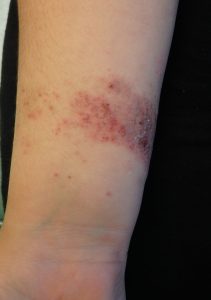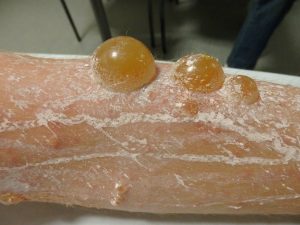Chapter 3: Eczematous Disorders
Contact Dermatitis
What is it?
Contact dermatitis can be broken into two forms: allergic contact dermatitis (20% of cases) and irritant contact dermatitis (80% of cases). In both cases, contact with a particular substance leads to changes in the skin making it itchy, especially in cases when the exposure happens over a long time.
What does it look like?
The classic features of allergic contact dermatitis are redness and blister formation at the site of contact with well-defined margins clearly showing the area of exposure. In some cases, the distribution may be linear as when a liquid runs down the skin or the patient brushes past a leaf or branch to which he/she is allergic. In other cases, the distribution is found to be a plaque that corresponds to exposure. After longer term exposure, the area usually becomes more scaly and thicker plaques with lichenification can be seen.

What causes it?
Allergic contact dermatitis is an immune-medicated reaction that occurs after sensitization. The first episode might take around 1 to 2 weeks for a reaction to develop. With re-exposure this can occur within few days. Chronic contact dermatitis can last for weeks due to frequent contact with the allergen. There are numerous allergens that can casue allergic contact dermatitis. Common encountered allergens include:
- Nickel – Found in many earrings, necklaces, bracelets, watches, cell phones and snaps/buckles of pants.
- Rubber – Rubber contains many substances such as latex and rubber accelerators used in processing. This can be seen in patients with allergy to the rubber in shoes.
- Plants – (rhus family) poison tree, poison oak, poison ivy, and mango (the underside of the skin has a compound similar to poison ivy).
- Paraphenylenediamine- found in hair dyes and black henna.
- Methylchloroisothiazolinone (MCI)/methylisothiazolinone (MI)- in diaper area found in wet wipes.
- Fragrances and dyes – including perfume, hair dye, and fragrance/color added to shampoo/soap/cosmetics/laundry detergent and etc.
- Medications – topical antibiotics like polymyxin B, bacitracin, neomycin, gentamycin are common cause of allergic contact dermatitis.
- Adhesives- found on dressings, this should not be confused with irritant contact dermatitis from wound discharge or topical antiseptic under the dressings.
- Toilet seat- can cause both allergic and irritant contact dermatitis, the former from the paint or material used and the later usually from the antiseptics or bleach used to clean them.
Irritant Contact dermatitis: Irritant dermatitis is not caused by an allergic, immune mediated response to a substance, but by direct injury due to exposure to a toxic substance, most commonly a chemical exposure. Immediate findings include a burning sensation, redness, swelling and at times blistering and peeling. Long-term, low-level exposures can cause redness and peeling with itch and burning sensation. The most common cause of irritant contact dermatitis is frequent work with detergents and in water. Oils, organic solvents, cement, and food handling (particularly raw meat) can cause irritant contact dermatitis.
How is it diagnosed?
Diagnosis of contact dermatitis is usually by clinical appearance and history. Patch testing (application of small amounts of the allergen in question to the skin in a small chamber) can be used to demonstrate allergy and can narrow down the cause of the allergy. A standard allergy patch test usually contains numerous allergens that can be tested at the same time. The test is different than the prick test which identifies type I reactions or IgE mediated hypersensitivity compared to patch test which is a type IV delayed hypersensitivity reaction.


How is it treated?
The appropriate treatment is avoidance of skin contact with the substance that causes the rash. In some cases, this is very difficult, and protecting the skin is the best alternative. For example, use gloves to avoid contact with known chemicals at work, or coat all nickel products with clear nail polish to prevent skin contact. Topical corticosteroids are the most common treatments for acute lesions. For short term use in acute situations, mid-potentcy corticosteroids are appropriate. For those with extensive involvement, oral steroids may be necessary and should be continued as a tapering dose over 2 weeks to prevent a return of symptoms at the end of treatment. For more chronic reactions, choice of topical steroid or steroid sparing agent mimics choices made in treatment of atopic dermatitis.

